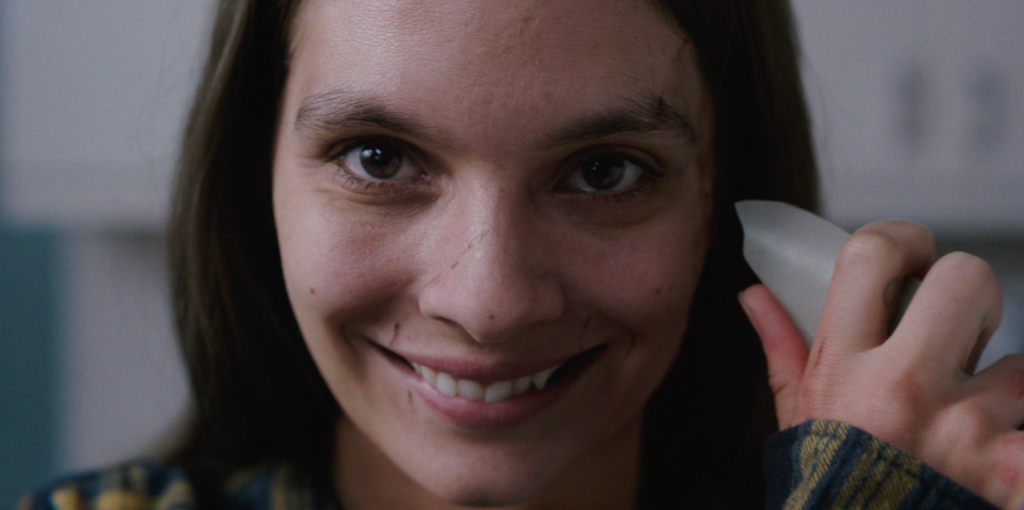In the world of horror, there are two times of year that are often considered dumping grounds for movies that studios don’t have much faith in. The first is in the early months of the year, as January and February has most audiences focusing on the films nominated for awards from the previous year instead of critiquing the merits of genre stories. The other dumping ground is heading into the Halloween season, because even if a movie isn’t great, studios know that audiences will be hungry for any horror. The marketing campaign for Smile might lead many to believe it was a relatively generic horror film just hoping to cash in on seasonal excitement, especially since it’s not a recognizable franchise and doesn’t rely on famous stars. The actual film, however, is a pleasant surprise, full of hugely effective scares, which mostly mask the razor-thin plot and almost manage to say some powerful things about mental health, depression, and trauma.
Videos by ComicBook.com
In hopes of distracting herself from her own emotional troubles, psychiatrist Rose (Sosie Bacon) takes on too many shifts helping mental health patients facing a crisis, until one frantic patient claims she’s seeing a smiling and supernatural presence following her, resulting in her committing suicide in front of Rose. Soon after, Rose herself begins having visions of such figures, leading her on a disturbing and desperate investigation to figure out the root of this curse and how to stop it.
The experience of watching Smile is entirely exhausting. The opening sequence of the first suicide is tense, engaging, and frightening, which also contains at least one massive and well-crafted scare from writer/director Parker Finn. Not only does this opening kick off a ticking clock for Rose, it also kicks off a ticking clock for the audience, as the rest of the film features similar massive scares on what feels like preordained intervals of 8-10 minutes. As soon as one major scare happens, there’s immediately some relief, though your body slowly starts bracing itself for how many more minutes until the next major scare. Structurally, it feels like the scares were the film’s priority and a narrative was constructed in service of those scares.
If startling and shocking moments are what you’re looking for in a horror film, then Smile absolutely delivers. Finn has perfected (at least for his own story) how to ratchet up the tension, offer a misdirect, and then release that tension in effective and frightening ways. Regardless of the merits of other genre efforts released this year, Smile might have the biggest scares you’ll get in a theater in 2022. If nuanced and subtle character stories are more of what you’re after in a film, then it’s easy to grow tired with the repetitive structure of Smile and the assault on your senses. Given that Smile began its life as the short film “Laura Hasn’t Slept,” this feature almost feels like a compilation of shorts that all center on the same character, each one with its own tremendously terrifying payoff.
Around halfway through the film, audiences see Rose applying makeup so she can go to her nephew’s birthday party, with the makeup only barely masking her tears. Rose practices smiling in the mirror, clearly to put up a facade that everything is okay, though audiences know just how much emotional turmoil she is suffering. It becomes clear in this moment that, despite the overt supernatural elements at play, the actual narrative serves as a metaphor for trauma and the need to mask your actual feelings behind a smile. By constantly withholding how you really feel from those around you, the mental struggles you’re coping with will only go stronger, to the point that they could result in tragic or permanent repercussions. It’s a clever and nuanced point that the film manages to sell, thanks in large part to the performance of Bacon, as her character has clearly gone through both more obvious and more innocuous emotional struggles.
In the wake of this sequence, the mythology of what’s happening goes from being a metaphor for trauma into being an allegory that loses both its subtleties and its effectiveness, leading to a relatively absurd crescendo. Even though the story gets a bit more heavy-handed and bizarre, the concepts and visual delivery of these themes are still quite shocking and inventive to see in a movie that will be released on a scale as wide as Smile, guaranteeing that audiences around the world are in for a wild ride, regardless of the emotional impact of its messages. Speaking of which, there are some truly troubling messages that the film sends for what happens to those who struggle with trauma and grief, as there are implications that these struggles are inescapable. This seems to be more of a choice for the filmmaker to tell a horror story as opposed to one that is inspiring, though, still, the message is troubling nonetheless.
Fans of A-horror like Ju-On or Ringu, as well as their American remakes The Grudge and The Ring, will notice a lot of similarities in Smile to the structure of passing a supernatural curse along to stay alive. While that structure doesn’t feel entirely fresh, the option to go for massive jump-scares as opposed to the more subtle moments of tension and unease of A-horror films does bring a new perspective to the genre to an inarguably effective degree. For those looking for a more nuanced experience that emphasizes story and character development, you’ll be left feeling mixed, but if you’re looking for a rollercoaster of terror, than this movie gives you a lot to smile about.
Rating: 3 out of 5
Smile lands in theaters on September 30th.









